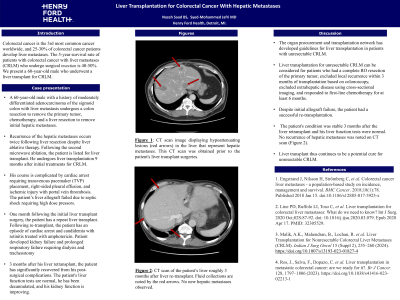Monday Poster Session
Category: Liver
P3014 - Liver Transplantation for Colorectal Cancer With Hepatic Metastases
Monday, October 28, 2024
10:30 AM - 4:00 PM ET
Location: Exhibit Hall E

Has Audio
- NS
Nazeh Saad, BS
Wayne State University School of Medicine
Dearborn Heights, MI
Presenting Author(s)
Nazeh Saad, BS1, Syed-Mohammed Jafri, MD2
1Wayne State University School of Medicine, Dearborn Heights, MI; 2Henry Ford Health, Detroit, MI
Introduction: Colorectal cancer is the 3rd most common cancer worldwide, and 25-30% of colorectal cancer patients develop liver metastases. The 5-year survival rate of patients with colorectal cancer with liver metastases (CRLM) who undergo surgical resection is 40-50%. Liver transplantation is being investigated as a potentially curative treatment for CRLM. We present a 60-year-old male who underwent a liver transplant for CRLM.
Case Description/Methods: A 60-year-old male with a history of moderately differentiated adenocarcinoma of the sigmoid colon with liver metastasis undergoes a colon resection to remove the primary tumor, chemotherapy, and a liver resection to remove initial hepatic metastases. Recurrence of the hepatic metastases occurs twice following liver resection despite liver ablative therapy.
Following the second microwave ablation, the patient is listed for liver transplant. He undergoes liver transplantation 9 months after initial treatments for CRLM. Explant pathology reveals three foci of residual metastatic adenocarcinoma with partial treatment response. His course is complicated by cardiac arrest requiring transvenous pacemaker (TVP) placement, right-sided pleural effusion, and ischemic injury with portal vein thrombosis. The patient’s liver allograft failed due to septic shock requiring high dose pressors. One month following the initial liver transplant surgery, the patient has a repeat liver transplant. Following re-transplant, the patient has an episode of cardiac arrest and candidemia with retinitis treated with amphotericin. Patient developed kidney failure and prolonged respiratory failure requiring dialysis and tracheostomy. Six weeks after the liver re-transplant, the patient’s symptoms and liver function tests improved.
Discussion: The organ procurement and transplantation network has developed guidelines for liver transplantation in patients with unresectable CRLM. Liver transplantation for unresectable CRLM can be considered for patients who had a complete RO resection of the primary tumor, excluded local recurrence within 3 months of transplantation based on colonoscopy, excluded extrahepatic disease using cross-sectional imaging, and responded to first-line chemotherapy for at least 6 months. Despite initial allograft failure, the patient had a successful re-transplantation which indicates that liver transplant continues to be a potential cure for unresectable CRLM.
Disclosures:
Nazeh Saad, BS1, Syed-Mohammed Jafri, MD2. P3014 - Liver Transplantation for Colorectal Cancer With Hepatic Metastases, ACG 2024 Annual Scientific Meeting Abstracts. Philadelphia, PA: American College of Gastroenterology.
1Wayne State University School of Medicine, Dearborn Heights, MI; 2Henry Ford Health, Detroit, MI
Introduction: Colorectal cancer is the 3rd most common cancer worldwide, and 25-30% of colorectal cancer patients develop liver metastases. The 5-year survival rate of patients with colorectal cancer with liver metastases (CRLM) who undergo surgical resection is 40-50%. Liver transplantation is being investigated as a potentially curative treatment for CRLM. We present a 60-year-old male who underwent a liver transplant for CRLM.
Case Description/Methods: A 60-year-old male with a history of moderately differentiated adenocarcinoma of the sigmoid colon with liver metastasis undergoes a colon resection to remove the primary tumor, chemotherapy, and a liver resection to remove initial hepatic metastases. Recurrence of the hepatic metastases occurs twice following liver resection despite liver ablative therapy.
Following the second microwave ablation, the patient is listed for liver transplant. He undergoes liver transplantation 9 months after initial treatments for CRLM. Explant pathology reveals three foci of residual metastatic adenocarcinoma with partial treatment response. His course is complicated by cardiac arrest requiring transvenous pacemaker (TVP) placement, right-sided pleural effusion, and ischemic injury with portal vein thrombosis. The patient’s liver allograft failed due to septic shock requiring high dose pressors. One month following the initial liver transplant surgery, the patient has a repeat liver transplant. Following re-transplant, the patient has an episode of cardiac arrest and candidemia with retinitis treated with amphotericin. Patient developed kidney failure and prolonged respiratory failure requiring dialysis and tracheostomy. Six weeks after the liver re-transplant, the patient’s symptoms and liver function tests improved.
Discussion: The organ procurement and transplantation network has developed guidelines for liver transplantation in patients with unresectable CRLM. Liver transplantation for unresectable CRLM can be considered for patients who had a complete RO resection of the primary tumor, excluded local recurrence within 3 months of transplantation based on colonoscopy, excluded extrahepatic disease using cross-sectional imaging, and responded to first-line chemotherapy for at least 6 months. Despite initial allograft failure, the patient had a successful re-transplantation which indicates that liver transplant continues to be a potential cure for unresectable CRLM.
Disclosures:
Nazeh Saad indicated no relevant financial relationships.
Syed-Mohammed Jafri: Gilead, Takeda, Abbvie, Intercept, VectivBio – Advisor or Review Panel Member, Speakers Bureau.
Nazeh Saad, BS1, Syed-Mohammed Jafri, MD2. P3014 - Liver Transplantation for Colorectal Cancer With Hepatic Metastases, ACG 2024 Annual Scientific Meeting Abstracts. Philadelphia, PA: American College of Gastroenterology.
